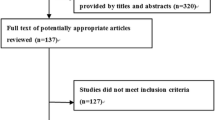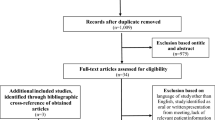Abstract
Purpose
To assess the infection eradication rate when using two types of articulating spacers (prosthetic articulating spacers and all-cement articulating spacers) in two-stage revision of infected total knee arthroplasty (TKA).
Methods
We comprehensively searched PubMed, Embase, and the Cochrane Library databases and performed a systematic review and meta-analysis of retrospective comparative studies assessing two types of articulating spacers. A quality assessment of the included studies was performed following the STROBE statement.
Results
Thirty retrospective studies, including a total of 821 knees, were identified. The pooled infection control rates in stage I were as follows: 0.98 (95% confidence interval [CI], 0.97 to 1.00) and 0.98 (95% CI, 0.96 to 0.99) for the prosthetic articulating spacer group and all-cement articulating spacer group, respectively. The pooled postoperative reinfection rate was 0.05 (95% CI, 0.03 to 0.08) for the prosthetic spacer group and 0.03 (95% CI, 0.01 to 0.06) for the all-cement spacer group. Results of the subgroup analyses showed that the weight of the antibiotic cement, antibiotic type, mean period of spacers in situ, postoperative antibiotic treatment period, and postoperative antibiotic treatment approach had no effect on the reinfection rates (p < 0.05).
Conclusions
Compared to all-cement articulating spacers, articulating spacers containing bio-inert materials have a similar infection control rate but a higher postoperative reinfection rate. Although the 95% CIs of reinfection rates in the two groups overlapped, our results indicate that articulating spacers containing bio-inert materials may be associated with higher reinfection rates and poorer clinical outcomes than all-cement articulating spacers.






Similar content being viewed by others
References
Lee YS, Chen AF (2018) Two-stage reimplantation in infected total knee arthroplasty. Knee Surg Rel Res 30(2):107–114. https://doi.org/10.5792/ksrr.17.095
George J, Miller EM, Curtis GL, Klika AK, Barsoum WK, Mont MA, Higuera CA (2018) Success of two-stage reimplantation in patients requiring an interim spacer exchange. J Arthroplasty 33(7 s):S228–Ss232. https://doi.org/10.1016/j.arth.2018.03.038
Charette RS, Melnic CM (2018) Two-stage revision arthroplasty for the treatment of prosthetic joint infection. Current reviews in musculoskeletal medicine 11(3):332–340. https://doi.org/10.1007/s12178-018-9495-y
Chang MJ, Song MK, Shin JH, Yoon C, Chang CB, Kang SB (2018) Two-stage approach to total knee arthroplasty using colistin-loaded articulating cement spacer for vancomycin-resistant Pseudomonas aeruginosa infection in an arthritic knee. Eur J Orthopaedic Surg Traumatol. https://doi.org/10.1007/s00590-018-2268-x
Anagnostakos K, Fink B (2018) Antibiotic-loaded cement spacers—lessons learned from the past 20 years. Expert Rev Med Dev 15(3):231–245. https://doi.org/10.1080/17434440.2018.1435270
Lu J, Han J, Zhang C, Yang Y, Yao Z (2017) Infection after total knee arthroplasty and its gold standard surgical treatment: Spacers used in two-stage revision arthroplasty. Intractable Rare Dis Res 6(4):256–261. https://doi.org/10.5582/irdr.2017.01049
Ding H, Yao J, Chang W, Liu F (2017) Comparison of the efficacy of static versus articular spacers in two-stage revision surgery for the treatment of infection following total knee arthroplasty: a meta-analysis. J Orthop Surg Res 12(1):151. https://doi.org/10.1186/s13018-017-0644-6
Massin P, Delory T, Lhotellier L, Pasquier G, Roche O, Cazenave A, Estellat C, Jenny JY (2016) Infection recurrence factors in one- and two-stage total knee prosthesis exchanges. Knee Surg, Sports Traumatol, Arthrosc 24(10):3131–3139. https://doi.org/10.1007/s00167-015-3884-1
Emerson RH Jr, Muncie M, Tarbox TR, Higgins LL (2002) Comparison of a static with a mobile spacer in total knee infection. Clin Orthop Relat Res (404):132–138
Ocguder A, Firat A, Tecimel O, Solak S, Bozkurt M (2010) Two-stage total infected knee arthroplasty treatment with articulating cement spacer. Arch Orthop Trauma Surg 130(6):719–725. https://doi.org/10.1007/s00402-010-1054-y
Spivey JC, Guild GN, Scuderi GR (2017) Use of articulating spacer technique in revision total knee arthroplasty complicated by sepsis: a systematic meta-analysis. Orthopedics 40(4):212–220. https://doi.org/10.3928/01477447-20170208-06
Moher D, Liberati A, Tetzlaff J, Altman DG, Group P (2009) Preferred reporting items for systematic reviews and meta-analyses: the PRISMA statement. J Clin Epidemiol 62(10):1006–1012. https://doi.org/10.1016/j.jclinepi.2009.06.005
von Elm E, Altman DG, Egger M, Pocock SJ, Gotzsche PC, Vandenbroucke JP, Initiative S (2007) Strengthening the reporting of observational studies in epidemiology (STROBE) statement: guidelines for reporting observational studies. BMJ 335(7624):806–808. https://doi.org/10.1136/bmj.39335.541782.AD
Anderson JA, Sculco PK, Heitkemper S, Mayman DJ, Bostrom MP, Sculco TP (2009) An articulating spacer to treat and mobilize patients with infected total knee arthroplasty. J Arthroplast 24(4):631–635. https://doi.org/10.1016/j.arth.2008.04.003
Brunnekreef J, Hannink G, Malefijt Mde W (2013) Recovery of knee mobility after a static or mobile spacer in total knee infection. Acta Orthop Belg 79(1):83–89
Castelli C, Gotti V, Ferrari R (2014) Two-stage treatment of infected total knee arthroplasty: two to thirteen year experience using an articulating preformed spacer. Int Orthop 38(2):405–412. https://doi.org/10.1007/s00264-013-2241-6
Choi HR, Malchau H, Bedair H (2012) Are prosthetic spacers safe to use in 2-stage treatment for infected total knee arthroplasty? J Arthroplast 27(8):1474–1479.e1471. https://doi.org/10.1016/j.arth.2012.02.023
Classen T, von Knoch M, Wernsmann M, Landgraeber S, Loer F, Jager M (2014) Functional interest of an articulating spacer in two-stage infected total knee arthroplasty revision. Orthop Traumatol Surg Res 100(4):409–412. https://doi.org/10.1016/j.otsr.2014.01.010
Cuckler JM (2005) The infected total knee: management options. J Arthroplast 20(4 Suppl 2):33–36
Durbhakula SM, Czajka J, Fuchs MD, Uhl RL (2004) Antibiotic-loaded articulating cement spacer in the 2-stage exchange of infected total knee arthroplasty. J Arthroplast 19(6):768–774
Freeman MG, Fehring TK, Odum SM, Fehring K, Griffin WL, Mason JB (2007) Functional advantage of articulating versus static spacers in 2-stage revision for total knee arthroplasty infection. J Arthroplast 22(8):1116–1121. https://doi.org/10.1016/j.arth.2007.04.009
Garg P, Ranjan R, Bandyopadhyay U, Chouksey S, Mitra S, Gupta SK (2011) Antibiotic-impregnated articulating cement spacer for infected total knee arthroplasty. Indian J Orthop 45(6):535–540. https://doi.org/10.4103/0019-5413.87126
Ha CW (2006) A technique for intraoperative construction of antibiotic spacers. Clin Orthop Relat Res 445:204–209. https://doi.org/10.1097/01.blo.0000201161.52196.c5
Hofmann AA, Goldberg T, Tanner AM, Kurtin SM (2005) Treatment of infected total knee arthroplasty using an articulating spacer: 2- to 12-year experience. Clin Orthop Relat Res (430):125–131
Hsu YC, Cheng HC, Ng TP, Chiu KY (2007) Antibiotic-loaded cement articulating spacer for 2-stage reimplantation in infected total knee arthroplasty: a simple and economic method. J Arthroplasty 22(7):1060–1066. https://doi.org/10.1016/j.arth.2007.04.028
Huang HT, Su JY, Chen SK (2006) The results of articulating spacer technique for infected total knee arthroplasty. J Arthroplasty 21(8):1163–1168. https://doi.org/10.1016/j.arth.2006.01.028
Jämsen E, Sheng P, Halonen P, Lehto MU, Moilanen T, Pajamäki J, Puolakka T, Konttinen YT (2006) Spacer prostheses in two-stage revision of infected knee arthroplasty. Int Orthop 30(4):257–261. https://doi.org/10.1007/s00264-006-0102-2
Jia YT, Zhang Y, Ding C, Zhang N, Zhang DL, Sun ZH, Tian MQ, Liu J (2012) Antibiotic-loaded articulating cement spacers in two-stage revision for infected total knee arthroplasty: individual antibiotic treatment and early results of 21 cases. Chin J Traumatol 15(4):212–221
Kalore NV, Maheshwari A, Sharma A, Cheng E, Gioe TJ (2012) Is there a preferred articulating spacer technique for infected knee arthroplasty? A preliminary study. Clin Orthop Relat Res 470(1):228–235. https://doi.org/10.1007/s11999-011-2037-1
Kim YS, Bae KC, Cho CH, Lee KJ, Sohn ES, Kim BS (2013) Two-stage revision using a modified articulating spacer in infected total knee arthroplasty. Knee Surg Rel Res 25(4):180–185. https://doi.org/10.5792/ksrr.2013.25.4.180
Lee BJ, Kyung HS, Yoon SD (2015) Two-stage revision for infected total knee arthroplasty: based on autoclaving the recycled femoral component and intraoperative molding using antibiotic-impregnated cement on the tibial side. Clin Orthop Surg 7(3):310–317. https://doi.org/10.4055/cios.2015.7.3.310
Lee JK, Choi CH (2012) Two-stage reimplantation in infected total knee arthroplasty using a re-sterilized tibial polyethylene insert and femoral component. J Arthroplasty 27(9):1701–1706.e1701. https://doi.org/10.1016/j.arth.2012.03.013
Meek RM, Dunlop D, Garbuz DS, McGraw R, Greidanus NV, Masri BA (2004) Patient satisfaction and functional status after aseptic versus septic revision total knee arthroplasty using the PROSTALAC articulating spacer. J Arthroplasty 19(7):874–879
Park SJ, Song EK, Seon JK, Yoon TR, Park GH (2010) Comparison of static and mobile antibiotic-impregnated cement spacers for the treatment of infected total knee arthroplasty. Int Orthop 34(8):1181–1186. https://doi.org/10.1007/s00264-009-0907-x
Pascale V, Pascale W (2007) Custom-made articulating spacer in two-stage revision total knee arthroplasty. An early follow-up of 14 cases of at least 1 year after surgery. HSS J: Musculoskelet J Hosp Spec Surg 3(2):159–163. https://doi.org/10.1007/s11420-007-9048-1
Pitto RP, Castelli CC, Ferrari R, Munro J (2005) Pre-formed articulating knee spacer in two-stage revision for the infected total knee arthroplasty. Int Orthop 29(5):305–308. https://doi.org/10.1007/s00264-005-0670-6
Qiu XS, Sun X, Chen DY, Xu ZH, Jiang Q (2010) Application of an articulating spacer in two-stage revision for severe infection after total knee arthroplasty. Orthop Surg 2(4):299–304. https://doi.org/10.1111/j.1757-7861.2010.00103.x
Shen H, Zhang X, Jiang Y, Wang Q, Chen Y, Wang Q, Shao J (2010) Intraoperatively-made cement-on-cement antibiotic-loaded articulating spacer for infected total knee arthroplasty. Knee 17(6):407–411. https://doi.org/10.1016/j.knee.2009.11.007
Su YP, Lee OK, Chen WM, Chen TH (2009) A facile technique to make articulating spacers for infected total knee arthroplasty. J Chin Med Assoc: JCMA 72(3):138–145. https://doi.org/10.1016/s1726-4901(09)70039-5
Van Thiel GS, Berend KR, Klein GR, Gordon AC, Lombardi AV, Della Valle CJ (2011) Intraoperative molds to create an articulating spacer for the infected knee arthroplasty. Clin Orthop Relat Res 469(4):994–1001. https://doi.org/10.1007/s11999-010-1644-6
Villanueva-Martínez M, Ríos-Luna A, Pereiro J, Fahandez-Saddi H, Villamor A (2008) Hand-made articulating spacers in two-stage revision for infected total knee arthroplasty: good outcome in 30 patients. Acta Orthop 79(5):674–682. https://doi.org/10.1080/17453670810016704
McConoughey SJ, Howlin R, Granger JF, Manring MM, Calhoun JH, Shirtliff M, Kathju S, Stoodley P (2014) Biofilms in periprosthetic orthopedic infections. Future Microbiol 9(8):987–1007. https://doi.org/10.2217/fmb.14.64
Antony S, Farran Y (2016) Prosthetic joint and orthopedic device related infections. The role of biofilm in the pathogenesis and treatment. Infect Disord Drug Targets 16(1):22–27
Evans RP (2004) Successful treatment of total hip and knee infection with articulating antibiotic components: a modified treatment method. Clin Orthop Relat Res (427):37–46
Villa T, Carnelli D (2007) Experimental evaluation of the biomechanical performances of a PMMA-based knee spacer. Knee 14(2):145–153. https://doi.org/10.1016/j.knee.2006.11.010
Lanting BA, Lau A, Teeter MG, Howard JL (2017) Outcome following subluxation of mobile articulating spacers in two-stage revision total knee arthroplasty. Arch Orthop Trauma Surg 137(3):375–380. https://doi.org/10.1007/s00402-017-2630-1
Hoell S, Moeller A, Gosheger G, Hardes J, Dieckmann R, Schulz D (2016) Two-stage revision arthroplasty for periprosthetic joint infections: What is the value of cultures and white cell count in synovial fluid and CRP in serum before second stage reimplantation? Arch Orthop Trauma Surg 136(4):447–452. https://doi.org/10.1007/s00402-015-2404-6
Hofmann AA, Kane KR, Tkach TK, Plaster RL, Camargo MP (1995) Treatment of infected total knee arthroplasty using an articulating spacer. Clin Orthop Relat Res (321):45–54
Acknowledgements
We acknowledge Professor Jing Tian for selecting the topic and offering valuable suggestions. His instruction was a great help for the completion of our study.
Funding
There is no funding source.
Author information
Authors and Affiliations
Corresponding author
Ethics declarations
Conflict of interest
The authors declare that there are no conflicts of interest.
Ethical approval
This article does not contain any studies with human participants or animals performed by any of the authors.
Rights and permissions
About this article
Cite this article
Yu, Q., Luo, M., Wu, S. et al. Comparison of infection eradication rate of using articulating spacers containing bio-inert materials versus all-cement articulating spacers in revision of infected TKA: a systematic review and meta-analysis. Arch Orthop Trauma Surg 139, 695–707 (2019). https://doi.org/10.1007/s00402-019-03121-x
Received:
Published:
Issue Date:
DOI: https://doi.org/10.1007/s00402-019-03121-x




